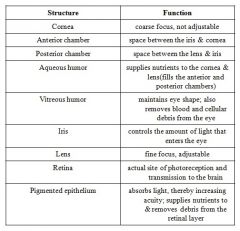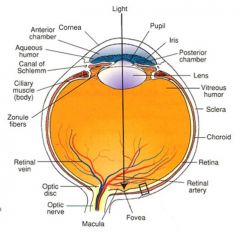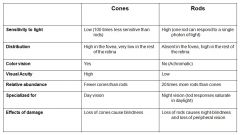![]()
![]()
![]()
Use LEFT and RIGHT arrow keys to navigate between flashcards;
Use UP and DOWN arrow keys to flip the card;
H to show hint;
A reads text to speech;
50 Cards in this Set
- Front
- Back
|
What are the three layers of the eye?
|
Sclera
Choroid Retina |
|
|
What is the sclera?
|
tough, white tissue except for the cornea which is tranparent
|
|
|
What is the choroid?
|
highly vascularized and includes the ciliary body and the iris
|
|
|
What is the retina?
|
consists of photoreceptors and pigmented epithelium
|
|
|
Do you know what the cornea, anterior chamber, posterior chamber, aqueous humor, vitreous humor, iris, lens, retina, and pigmented epitherlium are?
|

|
|
|
Do you know where the cornea, anterior chamber, posterior chamber, aqueous humor, vitreous humor, iris, lens, retina, and pigmented epitherlium all are?
|

|
|
|
What is glaucoma?
|
Increase pressure in anterior and posterior chambers due to an accumulation of aqueous humor; pressure is transmitted to the vitreous chamber which reduces blood supply
|
|
|
What is the Fovea?
|
In a region of thinned retina known as the macula lutea; thin so that there is minimum distortion. visual acuity due to being exclusively cones
|
|
|
What is the optic disc?
|
opening in eye through which blood vessels enter and axons leave; no photoreceptors which results in a blind spot
|
|
|
What is Papilledema?
|
swelling of the optic disc as a result of swelling of the brain; can be due to trauma, infection, or tumor
|
|
|
What is macular degeneration?
|
loss of photoreceptor cells that is limited to the macula; central vision affected most; dry which is loss of pigmented epithelium and wet which involves abnormal blood vessel growth
|
|
|
What is responsible for the focusing of light (refraction)?
|
lens and cornea
|
|
|
How does the lens adjust for far vision?
|
thin and flat
|
|
|
How does the lens adjust for near vision?
|
thicker and rounder
|
|
|
What controls lens shape?
|
ciliar muscles and zonule fibers
|
|
|
What are zonule fibers?
|
suspensory ligaments arranged radially to hold the lens in place; attached to lens and to ciliary muscles
|
|
|
When ciliary muscles contract what happens?
|
zonule fibers move towards the center of the eye and allow the lens to relax (get thicker); near vision requires contraction (aka accommodation)
|
|
|
How does pupil size influence visual clarity?
|
Smaller pupil size increases visual resolution and increases depth of field under normal light conditions
|
|
|
What are cataracts?
|
Clouding of the lens that disrupts the passage of light; occur when lens protein degenerates
|
|
|
What are the layers of the retina?
|
Pigment epithelium layer
Layer of Photoreceptor outer segments External limiting membrane layer Outer nuclear layer Outer plexiform layer Inner nuclear layer Inner plexiform layer Ganglion cell layer Optic nerve layer |
|
|
What is the Pigment epithelium layer?
|
Consists of cuboidal cells containing melanin; absorbs any light that doesn't get captured by the photosensitive cells preventing to degradation of the visual signal on the retina and preventing damaging levels of light onto the retina; also provides nutritional support to the photoreceptors
|
|
|
What is the reason for retinal detachment?
|
The weak connection between the pigment epithelium and the rest of the retina; leads to a loss of nutritional support
|
|
|
Which retinal layer contains bipolar cells?
|
Inner nuclear layer
|
|
|
Which retinal layer contains rods and cones?
|
Outer nuclear layer
|
|
|
Which layer contains ganglion cells?
|
Ganglion cell layer
|
|
|
What is retinitis pigmentosa?
|
Inherited visual disorder caused by progressive loss in vision due to degeneration of photoreceptors; clumps of pigment from pigment layer
|
|
|
What are the difference between rods and cones?
|

|
|
|
What is the difference between rods and cones?
|
Rods are extremely sensitive to light, but have low resolution.
Cones are relatively insensitive to light, but have high spatial resolution. |
|
|
What level of focus does the cornea provide?
|
Coarse
|
|
|
What is the relative distribution of photoreceptive cells in the retina?
|
High density cones in the fovea with rods absent; outside fovea mix of rods and cones with lower density of cones.
|
|
|
What photopigment do rods use?
|
Rhodopsin
|
|
|
What photopigments do cones use?
|
Violet (short), green (medium), and yellow (long); although each individual cone only uses one type of photopigment.
|
|
|
How are we able to detect so many different color with only three photopigments?
|
The visual system is able to compare the relative activities of cones with different photopigments to determine the color of the light.
|
|
|
What coding system allows for accurate color vision?
|
frequency coding
|
|
|
What is color blindness?
|
lack of cones that contain one of the three pigments; most common is red-green (loss of middle)
|
|
|
How do rods and cones respond to light?
|
Graded Changes in membrane potential; this results in hyperpolarization (synaptic transmission stops)
|
|
|
Describe the flow of information in the retina?
|
Light strikes the rods/cones --> Hyperpolarizes rods/cones decreasing neurotransmitter release --> bipolar cells are depolarized increasing their neurotransmitter release --> ganglion cells are depolarized and action potentials initiated
|
|
|
What is the process of adapting to the overall levels of illumination called?
|
light adaptation
|
|
|
What is involved in light adaptation?
|
Cones becoming less sensitive to light (increase in Ca2+ levels); pupil diameter change; neural circuitry changes
|
|
|
What are saccades?
|
small movements of the eye that occur when staring at a single image; prevent images from being projected on the same retinal region for too long
|
|
|
What is a stabilized retinal image?
|
focusing for a long time on a single image will cause the image to disappear; not normally experienced due to saccades
|
|
|
What is myopia?
|
Nearsighted; cannot bring distant objects into focus; caused by cornea being too curved or eye too long
|
|
|
what is hypermetropia?
|
Farsighted; cannot bring near objects in focus; caused by the eye being too short
|
|
|
What is emmetropia?
|
Normal vision
|
|
|
What is astigmatism?
|
Either lens or cornea lacks uniform curvature; light doesn't get focused onto the same point
|
|
|
What is one reason older eyes have trouble seeing?
|
elasticity of the lens decreases which results in less accommodation (less round lens --> less near vision)
|
|
|
What is presbyopia?
|
When minimal distance at which we can focus upon near object gets farther away; impairs detailed near vision tasks such as reading
|
|
|
How is red-green color blindness inherited?
|
X-linked recessive
|
|
|
Do bipolar cells have action potentials?
|
no
|
|
|
In dark what are rods and cones doing?
|
constantly releasing neurotransmitters that inhibit bipolar cells from releasing neurotransmitters
|

